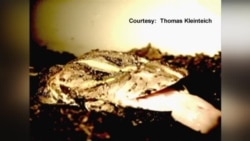From telescopes inspired by lobster eyes that see more of space, to new Japanese high-speed trains modeled after Kingfisher beaks, engineers who take cues from nature to fuel innovation are turning their attention to the sticky tongues of frogs.
Thomas Kleinteich, of Germany's Kiel University, wanted to know how the sticky tongues of frogs compare to the feet of the much-studied gecko, which can blaze a trail up a wall or race upside down across a ceiling.
“Basically it was interesting to study a new adhesive system in biology,” he said.
Kleinteich designed an experiment with the horned frog, a popular pet in Germany. Placed in a terrarium behind pressure sensitive glass, he tempted the frog with live crickets on the other side of the panel. The team then measured the forces on the glass as the frog tried to capture them.
“…like the tongue impact and also when the frog was pulling its tongue back trying to detach again from the glass slide," he said. "Then, of course, I also got the tongue print on the glass, after the tongue detached.”
Kleinteich and his co-workers did 80 trials using four frogs.
“What we actually found was that the tongue adhesive forces were well beyond the body weight of these frogs," he said. "And, another thing which we found, which I did not expect, was that the mucus or the slime on top of their tongues does not seem to be that important as people always assumed.”
While sticky feet can take geckos up walls, Kleinteich says, in one way, a frog tongue may be even more dynamic, because it is blindingly fast.
“… in a way that frog tongues [take] only a few milliseconds to actually establish contact," he said. "So it is not like having a piece of tape and to rub it against the wall and wait for a few seconds for [it to stick], [the frog] is immediate, in terms of less than 10 or 20 milliseconds.”
And since frogs have a diet that ranges from insects to small birds, their tongues can attach to many different surfaces, which Kleinteich says merits more study.
“The next steps for me will be, first to study the structure of the tongues and second also to compare multiple species to maybe find more general patterns to find how this mechanism may work. And in the far future I could think of some frog inspired adhesives, but this way beyond where we are at the moment. ”
Kleinteich's study is published in Scientific Reports.
Thomas Kleinteich, of Germany's Kiel University, wanted to know how the sticky tongues of frogs compare to the feet of the much-studied gecko, which can blaze a trail up a wall or race upside down across a ceiling.
“Basically it was interesting to study a new adhesive system in biology,” he said.
Kleinteich designed an experiment with the horned frog, a popular pet in Germany. Placed in a terrarium behind pressure sensitive glass, he tempted the frog with live crickets on the other side of the panel. The team then measured the forces on the glass as the frog tried to capture them.
“…like the tongue impact and also when the frog was pulling its tongue back trying to detach again from the glass slide," he said. "Then, of course, I also got the tongue print on the glass, after the tongue detached.”
Kleinteich and his co-workers did 80 trials using four frogs.
“What we actually found was that the tongue adhesive forces were well beyond the body weight of these frogs," he said. "And, another thing which we found, which I did not expect, was that the mucus or the slime on top of their tongues does not seem to be that important as people always assumed.”
While sticky feet can take geckos up walls, Kleinteich says, in one way, a frog tongue may be even more dynamic, because it is blindingly fast.
“… in a way that frog tongues [take] only a few milliseconds to actually establish contact," he said. "So it is not like having a piece of tape and to rub it against the wall and wait for a few seconds for [it to stick], [the frog] is immediate, in terms of less than 10 or 20 milliseconds.”
And since frogs have a diet that ranges from insects to small birds, their tongues can attach to many different surfaces, which Kleinteich says merits more study.
“The next steps for me will be, first to study the structure of the tongues and second also to compare multiple species to maybe find more general patterns to find how this mechanism may work. And in the far future I could think of some frog inspired adhesives, but this way beyond where we are at the moment. ”
Kleinteich's study is published in Scientific Reports.









